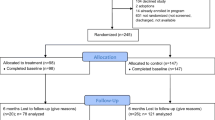Abstract
Most studies of family preservation services have used quantitative methods to examine program success. This paper reports on interviews with primary caretakers of children who have been abused and those with behavior problems between six months and three and one half years after family preservation services ended. Primary caretakers were asked three questions: What did you find to be the most helpful in your counseling? What did you find that did not help or that you disliked about counseling? After family preservation services, what happened with respect to the problems for which you were initially referred? Families found the support and nontraditional approaches to counseling helpful. Parents with children who had been abused particularly appreciated the teaching component of services. Brevity of the services and switching workers midstream caused the most concern for families. Finally, how families fared after intervention fell into a continuum from improved to deteriorated. The implications of these findings for clinical practice and program development are discussed.
Similar content being viewed by others
References
Coleman, H. (1995).A longitudinal study of a family preservation program. Unpublished doctoral dissertation, The University of Utah, Salt Lake City.
Coleman, H., & Unrau, Y. (1996). Analyzing your data. In L. Tutty, M. Rothery, & R. Grinnell (Eds.),The process of qualitative research: A step-by-step process (pp. 85–115). Needham Heights, MA: Allyn & Bacon.
Fraser, M., Pecora, P., & Haapala, D. (Eds.). (1991).Families in crisis. New York: Aldine de Gruyter.
Garbarino, J., & Gilliam, G. (1987).Understanding abusive families. Toronto: Lexington Books.
Isaacs, C. (1982). Treatment of child abuse: A review of the behavioral interventions.Journal of Applied Behavior Analysis, 15, 273–294.
Kinney, J., Haapala, D., & Booth, C. (1991).Keeping families together: The homebuilders model. Hawthorne, NY: Aldine de Gruyter.
Kinney, J., Haapala, D., Booth, C., & Leavitt, S. (1990). The Homebuilders model. In J. Whittaker, J. Kinney, E. Tracy, & C. Booth (Eds.),Reaching high-risk families (pp. 31–64). Hawthorne, NY: Aldine de Gruyter.
Lewis, R., & Johnson, A. (1993).The Utah foster care population: Profiles of sub-groups and implications for services. Salt Lake City, Utah: Office of Social Services, Utah Department of Human Services.
Lincoln, Y., & Guba, (1985). Naturalistic inquiry. Newbury Park, CA: Sage.
Lindof, T. (1995).Qualitative communication research methods. Thousand Oaks, California: Sage Publications.
Miller, S., & Sloane, H. (1976). The generalization effects of parent training across stimulus settings.Journal of Applied Behavior Analysis, 9, 355–370.
Patterson, G., Capaldi, D., & Bank, L. (1991). An early starter model for predicting delinquency. In D. Pepler & K. Rubin (Eds.),The development and treatment of childhood aggression (pp. 139–168). Hillsdale, NJ: Lawrence Erlbaum Associates.
Patton, M. (1992).Qualitative evaluation and research methods. Newbury Park, CA: Sage Publications.
Pecora, P., Bartholome, J., Magana, V., & Sperry, C. (1991). How consumers view intensive family preservation services. In M. Fraser, P. Pecora, & D. Haapala (Eds.),Families in crisis (pp. 273–288). New York: Aldine de Gruyter.
Rapp, C., & Poertner, J. (1987). Moving clients center stage through the use of client outcomes. In R. Patti, J. Poertner, & C. Rapp (Eds.),Managing for services effectiveness in social welfare organizations. (Special issue ofAdministration in Social Work, 11,(3–4), 23–38).
Rzepnicki, T. (1991). Enhancing the durability of intervention gains: A challenge for the 1990s.Social Service Review, 65(1), 92–111.
Sanders, J., & James, J. (1983). The modification of parent behavior: A review of generalization and maintenance.Behavior Modification, 7(1), 3–27.
Tutty, L., Rothery, M., & Grinnell, R. (1996).Qualitative research for social workers. Toronto: Allyn and Bacon.
Author information
Authors and Affiliations
Rights and permissions
About this article
Cite this article
Coleman, H., Collins, D. The voices of parents: A qualitative study of a family preservation program. Child Youth Care Forum 26, 261–278 (1997). https://doi.org/10.1007/BF02589419
Issue Date:
DOI: https://doi.org/10.1007/BF02589419




